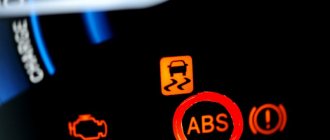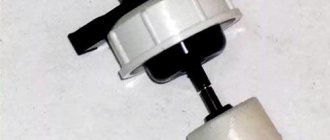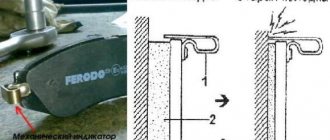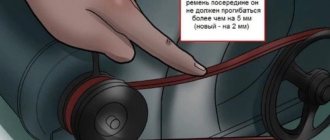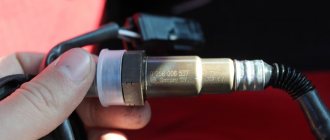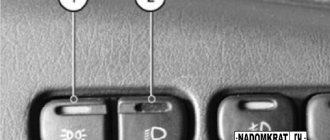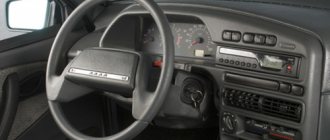25.10.2019
| (Votes: 8, Rating: 4.75) |
Issues discussed in the material:
- Why do you need a parking brake light?
- Why is the handbrake light on?
- What to do in this situation
- What to do if the parking brake light, on the contrary, does not light up
There is a special indicator on the dashboard, the so-called parking brake light. Often the indicator looks like an exclamation mark with arcuate lines on the sides. In addition, there may be the inscription “Brake”. If one or another type of symbol is active, you should stop and determine why the handbrake light is on.
Why do you need a parking brake light?
Most of the indicators found on the machine's console are alarm indicators. They show that the car has some kind of breakdown or something is faulty. In such a situation, you need to use the services of a car service center, where they will give your vehicle computer diagnostics and offer the necessary repairs.
Initially, if the handbrake light is on, this is not an indication of malfunctions or errors. Just a car on the handbrake, the indicator lights up when the handbrake is raised. If the lever is lowered, the light stops lighting. It is easy to understand that the indicator on the dashboard is connected to the brake mechanism.
In principle, you can see that the handbrake light comes on even with a slight change in the position of the lever. Lift it just a little, without reaching the first click. And now the contact has already closed, and the indicator lights up.
There is no light signal provided that the lever has reached its extreme horizontal position. And if the car starts moving, but the indicator is still on, it means that you did not lower the handbrake all the way. This circumstance confuses most motorists.
However, the glow of the indicator may also indicate some damage to the braking functions of the vehicle. In reality, the role of the light bulb is not only to signal the position of the lever. It also informs the driver about various malfunctions: the mechanism cable has stretched or the volume of “brake fluid” in the hydraulic system is insufficient. There may be a number of other factors that cause the indicator to light up.
If the handbrake light is on or flashes, flashes when the car is moving and does not respond at all to raising/lowering the brake lever, it means that the car has a problem with the brakes. This situation is very dangerous! You should immediately visit an auto repair shop and find out the reasons that caused the handbrake light to glow.
How does a mechanical handbrake work? Let's consider its principle of operation
Looking through the list of internal parts of this mechanism, we notice only one - a lever. There are cases when it can be replaced by a small pedal, located somewhat away from the main pedals responsible for driving the car. Using a number of parts, as well as tensioners and fuses, the lever is connected to mechanisms that block the rear wheels.
A ratcheting wheel is installed in the lever itself; it fixes the operating mode and is a safety device. The force transmitted by the driver is distributed over two or three cables, which are connected to the pads through special parts. A scheme with three parts is often used, these are two side ones that lead to two rear wheels, but the central cable plays an important role in the distribution of the applied forces. The drives are connected to each other through the main part - the block.
Specially designed levers are necessary to control the operation of the pads. There is their connection with the right and left cables in a situation when the lever is turned on and the fuse is triggered, they will precisely press the handbrake pads to the walls of the drums or rotors. All the main parts of the parking mechanism are aligned using tips that have a length that can be adjusted. If the cables are stretched, this will allow the tension to be adjusted to them without replacing all the internal components of this system. The manual parking mechanism is not the only representative; there is also a hydraulic type and an electronic one, which also have fuses.
Why is the handbrake light on?
There are not many reasons for the brake lever light to come on. Let's look at common factors that indicate why the parking brake light is constantly on:
- The car is put on the handbrake.
- The brake fluid volume is below the required level.
- The brake fluid reservoir is damaged: the float is faulty, the lid is cracked, the sensor is broken, etc.
- Problems have arisen in the electrical system: the connection of contacts has become insufficiently high quality at all points of the car’s brake circuit.
- The pads have worn out.
- The caliper is not working correctly.
- The machine's electronics are faulty. There may be a software failure, and, as a result, the indicator lights up erroneously.
- Various types of damage to the brake system occurred.
- The handbrake is faulty.
The handbrake lever can become unusable for several reasons:
- Long and intensive use of the handbrake, which resulted in chafing of the steel cable harnesses.
- Irreversible change in the properties of the material.
- Repeated use of the brake lever in cases of hasty braking. Consciously or in a state of fright, the driver can use all options to stop the vehicle.
- Kink or break in the handbrake cable.
If such a malfunction occurs, the cable must be replaced. You can perform this action in a viewing hole, on an overpass, or lying under the car.
Important:
Do not under any circumstances hit the road if the handbrake light is on. It is necessary to eliminate the problems that have arisen in the brake system on your own or seek help from a car repair shop.
What you need to know about electronic handbrake?
In an electronic parking brake, all important actions are performed by the car’s computer unit, as well as the handbrake sensor. When the engine is turned off, the system polls the tilt sensor, which measures the horizontal position of the vehicle. If horizontal violations are detected, the computer will activate the electronic handbrake drive, which, in turn, using a clamping screw, will activate the handbrake pads.
The parking lock can be turned off automatically when the car starts and the driver presses the gas pedal; for this, a sensor is used, the operation of which is controlled by a fuse. To artificially disable this type of handbrake, you need to press the pedal and the handbrake sensor will understand that it is necessary to disconnect the pads.
What to do if the parking brake light is constantly on
Each car enthusiast can determine problems with the brake mechanism himself. You just need to find an inspection hole, overpass or lift, then the help of auto repair shop mechanics will not be needed. However, if you are not confident in your abilities, it is better to turn to specialists.
Let's carry out some manipulations to find out why the handbrake light is on, even if it is lowered. You should:
- Repeatedly lower/raise the brake lever and see how the light reacts - this will determine whether the handbrake is working or not.
- Place the car on a flat surface and check the brake fluid volume.
- Add brake fluid if there is not enough of it, and check the operation of the handbrake light again.
- If no changes occur, remove the float sensor from the tank, clean it, and tap it to rule out problems with the float.
- Inspect the brake pads. If the wear is 80% or more, the indicator will light even when the lever is lowered. It is necessary to replace the pads with new ones.
After completing the suggested actions, is the handbrake light still on? This means that you have a direct route to a car repair shop, because it is better to entrust the diagnosis of the brake system to professionals.
Oldruck Motor Aus Error and Check Engine Light
Recently, a very large number of sensors have been installed on cars with German brains. Since the early 2000s, cars have been actively equipped with self-diagnosis systems. On the one hand, this is a great opportunity to reduce potential dangers on the road for the driver. On the other hand, this is a constant hassle, since inscriptions and messages appear constantly and irritate the car owner. The Oldruck Motor Aus inscription has the following features:
- translation of the error means that the oil pressure in the engine is broken, so the car quite naturally asks you to turn off the engine and check the problem in more detail;
- if the Check Engine light comes on along with this error, the problem may be related to several problems at once or simply to a break in the network of certain sensors;
- the first thing you need to do is stop the engine so as not to spoil it, get out of the car and check the oil level using the dipstick, this will prompt the first step of the solution;
- if the level is low, you should immediately add oil and try to start again, the error may repeat, in which case you should turn off the engine again and check the level again;
- Another likely problem could simply be a glitch in the on-board system or a failure of the oil pressure sensor, but it’s better not to drive to the service station under your own power, as this can lead to problems.
The best thing in this case would be to refuse to move under your own power and call a tow truck. You can also invite an expert from a service station to your garage or to the place where you are. If it is possible to replace the oil pressure sensor or connect basic diagnostic equipment, the technician will tell you exactly what problems caused the error to appear. You cannot simply continue driving with the Oldruck Motor Aus sign on; this can lead to engine failure.
What to do if the handbrake light does not light up
You need to check the operation of the handbrake if the indicator does not light up. Suspected faults:
- the element has failed;
- there was a break in the wires;
- There is no “+” on the light bulb.
There may be a fault in the alternator wiring. The wires that go to it are red and brown. Turn the ignition on and short the brown wire to any metal part. The battery indicator should light up together with the brake system lever (duplication occurs at start and lights up through the diode). The battery indicator is on, but the brake lever light is not on, which means the diode is damaged.
Recommendations from experienced drivers:
- Inspect the limit switch and its connector.
- Focusing on the end of the handle, find the hidden stopper, push it and pull it.
- Inspect the fuses.
- Inspect the fastener: is it securely attached to the plate and are there various foreign objects present?
- Use the car drive and move the handle up/down.
- Lightly hit the console. Sometimes it can give a positive result if the contact is simply not very good.
Often, a malfunction can occur due to the traction spring of the lever pawl, which is located inside. The problematic element should be changed. However, it is not always possible to do this. Simply remove and stretch the spring.
We recommend
“The airbag light is on: searching for causes and troubleshooting” More details
Let’s consider the sequence of actions for removing the latch and repairing it using the example of a VAZ car:
- remove the button by unscrewing it counterclockwise;
- remove the spring from the rod rod;
- try to stretch it by three centimeters;
- reverse steps to put everything in place.
Do not forget to read the instructions for the machine before performing any actions, this will definitely be beneficial.
How is a hydraulic hand brake designed and how does it work?
If you ask yourself about the operation of a hydraulic handbrake, you can find some similarities with a mechanical handbrake. There is also a lever available here, there is a ratchet (geared) wheel, but instead of cables there are some liquid pistons; they are connected to the hydraulic lines of the main brake system. The main positive feature of this modification is a simpler repair procedure. The driver also does not need to adjust anything. All mechanical functions are performed by hydraulics.
The disadvantage of this system is that if there is a violation in the tightness of the brake circuit, then the car will have no chance to brake in an emergency. Thus, the leakage of fluid will leave the car owner not only without the main brakes, but also the handbrake.
Possible reasons why the handbrake light is on: opinions of car owners
- Changed the hubs.
“The light in my car blinked sometimes. At first I decided that the problem was with the pads. But later I remembered - I replaced the pads not so long ago. I checked the brake, everything is fine. And then I thought about why the problem could arise? I didn’t think of anything and stopped worrying. The indicator continued to flash periodically... As a result, the right hub bearing began to make noise, after a while it began to hum so loudly that the sound simply made my head split. I first purchased one hub. Then I thought that it would be better to change both parts at once - or rather, this should be done. I bought a second one, changed it, and the problems all disappeared: no noise, no blinking light.” - Got a good technician!
“The handbrake light would come on from time to time while driving. Quite often this happened after bouncing on the pit. I went and bought a brake fluid. And I found a specialist right at the dealership. He then flooded it. He also climbed under the handbrake and said that perhaps the microphone at the lever was acting up (it seems like this happens sometimes). Take the train and watch. But the problem disappeared after filling the brake fluid. The handbrake no longer lights up. By the way, I met an excellent specialist and looked for the problem for free, with pleasure and without showing off.” - Depending on the situation,
“If the light starts to light up after shocks, for example, on a hole or bump, then, most likely, the brake fluid level is on the verge of the required level or lower. You just need to add it and that's it. If it lights up when braking, the pads are definitely worn out completely. I went through this myself in my VAZ.
Checking the mechanical component
Self-diagnosis is a simple operation. It is divided into two components - mechanical and electrical. The first is very important, since it evaluates the condition of the brake system drive and determines its performance.
Checking the mechanical component is reduced to assessing the level of brake fluid in the reservoir and the condition of the drive lines and system components - the master brake cylinder and operating mechanisms.
The brake reservoir is located in the engine compartment, on the right near the rear panel of the engine compartment. It is not difficult to find it, since there are two wires going to the tank cap.
When checking, disconnect the wires and unscrew the cap to determine the brake fluid level. There are marks on the walls of the tank, by which you can understand how much liquid is left. A level above the middle between the marks is considered normal.
A drop below o indicates a fluid leak. Therefore, the next stage is checking the lines and brake mechanisms. To do this, inspect the wheels from the inside. If we find a fluid leak from the mechanisms, then we see smudges on the disks.
For an additional check, we start the car and press the brake pedal a couple of times, after which we roll the car back and inspect the surface of the ground for traces of leaking fluid, and check the fluid level. If it is detected, the brake line is damaged, and the amount of fluid will decrease.
If there is a brake fluid leak, the car cannot be used because the car does not have brakes. The best option in this case is to call a tow truck to deliver the car to the repair site. But if you have enough driving experience, then we get to the service station or garage on our own. Car brake systems usually have two circuits, and if the line of one of them is broken, the second continues to work.
Currently reading: Checking and adjusting the brake pedal - Section 9. Brake system - Renault Logan (Renault Logan) repair and maintenance
Sometimes there is a problem with the warning light coming on when you press the brake pedal. The reason for this lies in two factors - low fluid level in the reservoir and worn disc brake pads. When braking, fluid flows into the working cylinders and the amount in the tank drops below a critical level, which is why the lamp lights up. This can be treated by installing new pads and adding fluid to the reservoir.
ABS turns on randomly, the light blinks or lights up periodically
One of the most difficult forms of breakdowns is the constant blinking of the ABS light bulb. This means that the anti-lock braking system sensors send incorrect signals to the computer, which, in turn, issues other incorrect commands to the vehicle's systems and modules. In such cases, many people prefer to simply turn off the anti-lock system, since unpleasant incidents may occur. For example, turning on ABS at a speed of 90 kilometers per hour with light braking can damage the chassis of the car and contribute to a complete loss of control over control. It's better to do this:
- bring the car to a service center for diagnostics, find out the reason for the chaotic operation of the equipment;
- for domestic cars equipped with a primitive anti-blocking device, it is better to immediately disable the system;
- complex designs and on-board electronic systems of foreign cars will have to be reflashed for repair;
- on some machines it will be easier to find the problem and fix it than to disable the anti-lock;
- you need to keep in mind that this particular system is not always the cause of the ABS light coming on; the problems can be different;
- During the diagnostic process, it is better to check the entire on-board electrical system and equipment.
By paying a certain amount for a car inspection, you can get the right answers to important questions. Sometimes a light that comes on on the panel can develop into a full-fledged repair of important units and components of the car, so you will have to spend a lot. But in most cases, this problem is not so expensive to solve. The cost of repair work depends, of course, on the make and model of the car, and on the price of spare parts. If an ABS sensor for a domestic car costs from 600 rubles, then a Japanese SUV will cost more than 10,000 rubles to replace one such sensor. We suggest watching a video about solving a similar problem using computer diagnostics:
Checking the brake fluid level
It would seem what hydraulics can have to do with the indicator of the handbrake indicator. However, one of the most common reasons for the constant glow of the light is precisely that there is not enough brake fluid in the hydraulic, that is, working system.
In order to check its level, you should do the following:
- The machine must be parked on a level surface. When the engine is cold, open the hood.
- We are looking for the hydraulic brake master cylinder. It is located in the rear of the engine compartment on the driver's side. We need a plastic white reservoir located above the cylinder. Cars manufactured before 1980 may have a metal cylinder. In this case, you will have to remove its cover to check the fluid level.
- Most reservoirs have marks indicating the minimum and maximum fluid levels. If it is approximately in the middle of these marks, then there is enough liquid.
- If necessary, liquid should be added to the tank. This must be done very carefully, as the substance is toxic and can cause corrosion of metal surfaces.
- Close the reservoir with a lid and lower the hood.
If the fluid level in the reservoir was significantly below the minimum mark, you should check the brake pads to see if they are worn out. Then the fluid will flow out of the pipes and flow to the brake calipers. As a result, fluid will quickly leak out of the system, and its level will not be enough for the normal functioning of the hydraulic system. This is one of the reasons why the handbrake light may be constantly on.
It should be noted that not on all car models the handbrake light comes on when driving if the brake pads are worn out.
Sometimes it happens that there is enough fluid in the reservoir, but the brake pedal still sticks. As a result, the handbrake light is constantly on, because the fluid does not reach the master cylinder. If you notice this problem, you should immediately take the car to a car service center, as significant damage may occur in the brake system.
Find out more about the new Logan
- Malfunctions of the brake system of Renault Logan Sandero (Renault Sandero Logan)
- Add oil to the Logan box
- Renault Logan muffler: replacement, articles of original spare parts and analogues
- Replacing antifreeze and flushing the system in Renault Logan: step-by-step instructions
- Renault Logan Stepway Life City 1.6 (113 hp) CVT - equipment and technical specifications on Drive
- All the main signs of a clutch failure and their causes. — New Logan
- Malfunctions of the brake system of Renault Logan Sandero (Renault Sandero Logan)
- Anti-roll bar Renault Logan
Parking brake light is flashing: most common causes
There can be many reasons for the handbrake blinking while driving, but if it happens like this, the problem is usually due to brake fluid.
Brake fluid is an important element of the braking system because it indirectly responds to the force with which the brake pistons press the brake pads against the brake rotors. As the brake pads wear, the level of brake fluid in the reservoir decreases. If the quantity is too low, a special sensor in the reservoir will transmit a signal to the car's computer, which will turn on the handbrake indicator on the dashboard.
Largus errors: how to look
After repairing the car, you can reset the codes yourself and without a scanner. To do this, you will need to completely disconnect the power from the on-board network, wait 15 minutes and return everything to its place.
The reset will be performed and the system will reset to normal.
Largus standard fault codes can be read independently. This will require a diagnostic scanner and primary knowledge of the operating principle of the device.
Specialization: Graduated from the State Automobile University, worked for 20 years at GAZ-56, now I drive a Zhiguli.
- Error p1615 Mercedes Sprinter
- Errors on Toyota Fortuner
- The battery charging lamp does not light up when the ignition of the Daewoo Nexia is turned on.
- Error steering wheel with exclamation mark grant
- Error u100b ford kuga 2
Airbag Fehler and various signals - the problem may be deep
When it comes to the Airbag Fehler inscription, many simply do not pay enough attention to it. But in fact, it is worth paying attention to such an error, since it does not always occur due to an error in the airbags. Even if the yellow indicators are flashing and the signal appears only once, you should pay special attention to the operation of the vehicle after such an error is issued. The problems can be very different:
- the airbag sensor, which is responsible for deploying this element, does not work, so it is necessary to carry out service in the near future;
- when a lamp lights up or blinks while moving, there are a number of reasons that are worth paying attention to; this is a huge list of problems, some of which are fatal;
- It happened that the Airbag Fehler error occurred among drivers of German and Czech cars when driving with a faulty generator or generator voltage regulator;
- perhaps the battery has begun to discharge and does not provide the necessary voltage to all sensors so that they receive normal operating conditions, the error can be absolutely anything;
- It is the Airbag error that occurs when a failure occurs in the electrical system in the car; this pattern cannot be understood even by the official service center.
There are a wide variety of problems associated with an airbag error. In fact, it turns out that the Volkswagen diagnostic system, although not the most effective, only issues a message when it really becomes necessary. So you should always pay attention to such errors and consult with specialists if they occur. Otherwise, you may have a hard time somewhere on the highway without possible help. By the way, if you are tired of the Volkswagen service signal, look at how you can reset this signal:
The inscription STOP! lights up when turning and braking
Probably one of the most popular types of error is the phrase “STOP! Brehmsenfehler. Betriebsanleitung.” Literally it translates as follows: Stop, brake system error, service required. This message may appear in combination with three or ten flashes of the red brake system symbol (handbrake) on the instrument panel, as well as a three-time sound signal. In this case, the inscription appears in the following situations:
- the car enters a right turn quite sharply or goes in an arc to the right for a long time, at the very extreme point an error and a signal may occur;
- if you accelerate too quickly, when the car is experiencing the heaviest loads, an error may occur and the emergency warning system will be activated;
- during sharp braking, an unpleasant sound may also occur, since the same mechanism works as when turning right; during sharp acceleration, the fluid exhibits inertia;
- during a series of sharp turns, when rocking occurs, in this case your car turns out to be quite irritable in terms of constantly displaying the STOP! error;
- when starting to move, when the car starts moving, as well as after stopping with more or less sharp braking - this is already a sign of an urgent need to intervene in the braking system.
Designation of icons on the Kia Rio dashboard
There are a large number of icons and symbols on the board. Their meaning is guessed intuitively, thanks to an understandable form. In this case, yellow or red signals indicate the presence of malfunctions.
- Pointer tachometer.
- Speedometer indicator – displays the current vehicle speed.
- If the yellow symbol of the car lights up while driving, a faulty immobilizer has been detected.
- Indication of power steering serviceability.
- Displays the performance of the SRS system.
- ABS module status indicator.
- The windshield washer reservoir is empty.
- Pointer indicator of fuel tank remaining.
- The blue icon indicates that the high beam headlights are turned on.
- There are less than 5 liters of fuel left in the tank - refueling is required.
- The front fog lights are activated.
- Likewise for stern optics.
- Turn on dimensions.
- The seat belt is not fastened - movement is prohibited.
- Indicators for the operation of turn signal breakers.
- On-board display, additional information for the driver is displayed here.
- Similar to point No. 15.
- Coolant temperature display.
- Critically low oil pressure in the engine boat.
- An orange icon appears when the handbrake is raised.
- Indicates an engine malfunction.
- The doors or cargo compartment lid are open.
- ECO. A green indicator indicates that the engine is operating in fuel saving mode.
Exclamation mark
Some Rio devices have an icon with an exclamation mark. Typically the indicator is designed to draw the driver's attention to the board and appears in conjunction with other icons.
On certain modifications of modules (4th generation), the symbol means detection of a puncture of one or more wheels (TPMS).
The engine icon on the Kia Rio dashboard came on
Such icons are displayed only if there are critical failures in the installation systems. When an indication appears, you must immediately stop the machine and eliminate the malfunction.
It is noteworthy that the lamp usually lights up together with other indicators - this significantly narrows the search range.
The battery icon is flashing on the Kia Rio dashboard
This indicator is directly related to the state of the battery. The icon is present on the dashboards of 2012 and 2014 models. In later versions, the emblem was moved to the on-board computer display.
As in other cars, the symbol indicates a severe loss of charge or a malfunction of the element. To eliminate the breakdown, you need to check the battery charge level and the generator wiring.
Tire pressure indicator
On tidy models after restyling 2016-2017, a standard TPMS system is installed.
The lamp indicating the operation of the system is displayed and looks like an exclamation mark inscribed in the tire profile. The icon indicates that one or more tires in the car are broken. To extinguish the lamp you need to remove the puncture.
ECO icon on the Kia Rio dashboard
The ECO sign turns on only when the fuel economy mode is turned on. In this case, the engine operates in a gentle mode with one cylinder turned off. The option is forcibly activated by the motorist by pressing a special button.
EPS icon
The icon is intended to indicate the correct operation of the vehicle's electronic stabilization system. The operating principle of the module is based on braking individual wheels in turns to maintain a given course. After the engine starts, the indicator should go out. If the lamp continues to light, this indicates a problem with the device. The car can move further, but with increased caution.
Fog light icon
The indicators for turning on the fog lights are purely informational. On models after 2015 there are two indicators located in the same area of the instrument panel.
Snowflake icon
Appeared on the dashboard of the Rio 3, released in 2022. The indicator lights up in the range from +5 to -5 degrees Celsius and means that icing may occur on the road surface. The symbol is for informational purposes only and has nothing to do with the work of onboard workers.
Error signs
When diagnosing, you can see error codes on the display of the car’s on-board computer. The most common variations are described below:
- 2 – DPKV – incorrect signal;
- 3 – DFR has failed or the circuit is open;
- 7 – the crankshaft is installed incorrectly (the marks are knocked off);
- 8 – Mass air flow sensor is missing or the signal is incorrect;
- 9 – DTOZH broken/damaged wiring;
- 10/11 – the actual intake air temperature does not correspond to the measured one;
- 12 – TPS has failed or is damaged;
- 16 – the recirculation valve is clogged;
- 18-21 – fuel injectors are not working properly;
- 24 – the fuel pump operates intermittently;
- 37 – depressurization of the intake system, mixture too lean;
- 48 – the adsorber purge valve is broken.
